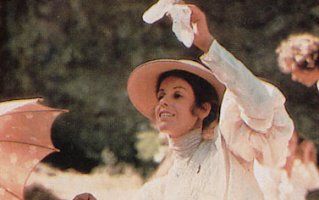
ROCKY HORROR: Newsweek March 5, 1979
"What we see and what we seem are but a dream-a dream within a
dream." This line, spoken under a mist-shrouded volcanic cliff, sets the
ethereal, mystical tone of PICNIC AT HANGING ROCK right from the start.
As he did in "The Last Wave," his excursion in to the occult world of
aborigines, Australian director Peter Weir is setting you up; behind his
lyrical surfaces he means to unearth a reality ordinary folks know not
of. "Hanging Rock," made in 1975, leaves no doubt that Weir is unusually
good at this sort of thing, one of the strongest talents in the booming
Australian movie industry.
The setting is a repressively proper Australian boarding school for
girls, run by one Mrs. Appleyard (Rachel Roberts) an imposing figure of
Victorian authority. On St. Valentine's Day, 1900, her white-clad
charges go off for an outing at Hanging Rock. Led by the angelic-looking
Miranda (Anne Lambert), four of the girls wander into the primeval
wilderness. One returns screaming in terror. The other three vanish.
What happened to them on the cliff? The question obsesses the
schoolgirls, the surrounding community and the young gentleman (Dominic
Guard) who spied on them with erotic interest as they started their
ascent. Were Miranda and her followers seeking a sexual apotheosis on
Hanging Rock, an escape from the life-denying restraints of the world?
After all, just before she disappeared, didn't she enigmatically remark:
"Everything begins and ends at exactly the right time"-as if she knew
what her fate would be?
Sexual Tensions: Not all of Weir's film is teasing
mystifications-it's also a biting commentary on the social and sexual
tensions that erupt in the school in the aftermath of the picnic. As the
school falls apart, Mrs. Appleyard becomes a figure of pathos, a
crumbling disciplinarian with frustrated lesbian yearnings. Gradually,
the sadistic, erotic underpinnings of this microcosmic society are
exposed.
It's an engrossing tale, and Weir's languid, sun-dappled images are
at once seductive and unnerving. Yet there's something hollow at the
core, an unearned sense of importance, a reliance on mere mood to
suggest mystical depths. Why does Weir-and why should the audience-so
easily accept these vanished schoolgirls as adolescent oracles, some
sort of pagan Cassandras? The symbolic burden of Hanging Rock inevitably
suggests the use of the Marabar Caves in E.M. Forster's "A Passage to
India," But the comparison only points up the shallowness of Weir's
conception. His movie is stylish and entertaining, but what he is
pushing as metaphysical profundity is closer to metaphysical mush.

|